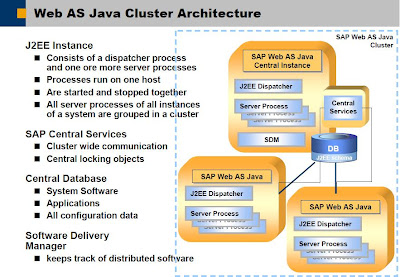
One Java Engine installation consists of:
One or more Java instances (Java Dispatcher, Server) and the Software Deployment Manager (SDM)
The Central Services (Messaging Service, Enqueue Service), which also create an instance (Central Instance)
Ax external database.
Changes in architecture of J2EE – Engine are made since 6.20
A J2EE Cluster now consists of an Central Service Instance. One Central Service Instance is required in the J2EE Cluster.
The Configuration of the J2EE Engines are now stored in a Database. Not any more stored in XML-Files in the file system. A database for the J2EE Cluster is required.
An Startup and Stop Framework is used.
In a large Java cluster installation, the load is distributed from a load balancer onto the different Java dispatchers.
Central Service - Message Service
Tasks of the Message service:
Notification of events that arise in the cluster.
Communication between different services
Forwarding of messages and requests to all participants (broadcast)
Prepare logon information for the SAP Web Dispatcher
Support for message server failover
Guaranteed message transmission
Exchange of cache information in the cluster

The Central Services run on one physical server and are one Java instance. They comprise the Message service and the Enqueue service.
The Central Services form the basis of communication and synchronization for the Java cluster.
Central Services are always required when a Java cluster is installed. They are started on a server with their own system number and the system ID (SID) of the whole system.
When Central Services are running, further Java instances (Dispatcher, Server) are started with the program JControl
The message service is a separate program used for communication between the elements of a Java cluster. It keeps a list of all processes (dispatchers and server) of the Java cluster. It represents the infrastructure for data exchange (small datasets only) between the participating nodes. The message service also supplies information to the SAP Web Dispatcher about Load Balancing.
Processes on Operating system level
NT : msg_server.exe
UNIX: msg_server
Trace file:
dev_ms in work directory of Central Service Instance
The settings and the status of the message service are made accessible to the administrator via the message Info Service in Visual Administrator described bellow.
Message server and Message Service are used synonymously. The correct expression would be that the Message Server is a process or program that provides the Message Service.
References :
TADMJ1 - SAP Java Engine Administration
ADM200 - SAP Web AS Java Administration



